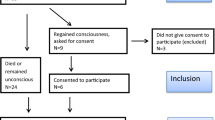Abstract
The aim of this study was to evaluate the accuracy and precision of non-invasive continuous blood pressure measurement by applanation tonometry (AT) in awake or anaesthetised cardiological intensive care patients. Patients suffering from highly impaired left ventricular function atrial fibrillation or severe aortic valve stenosis were included into the study. Arterial blood pressure was recorded by applanation tonometry (T-Line 400, Tensys Medical®, USA) and an arterial line in awake or anaesthetised patients. Discrepancies in mean (MAP), systolic (SAP), and diastolic (DAP) arterial pressure between the two methods were assessed as bias, limits of agreement and percentage error respectively. In 31 patients a total of 27,900 measurements were analyzed. The concordance correlation coefficient was 0.23, 0.45 and 0.06 for MAP, SAP and DAP, respectively. For all patients bias for MAPAT compared to MAPAL was 14.96 mmHg (SAPAT 4.51 mmHg; DAPAT 19.12 mmHg) with limits of agreement for MAPAT of 46.25 and − 16.33 mm Hg (SAPAT 48.00 and − 38.98 mmHg; DAPAT 50.12 and − 11.89 mmHg). Percentage error for MAPAT was 56.8% (42.7% for SAPAT; 75.2% for DAPAT). We conclude that the AT method is not reliable in ICU patients with severe cardiac comorbidities.




Similar content being viewed by others
References
Mandel M, Dauchot P. Radial artery cannulation in 1000 patients: precautions and complications. J Hand Surg. 1977;2(6):482–5.
Wilkins R. Radial artery cannulation and ischaemic damage: a review. Anaesthesia. 1985;40:896–9.
Bendjelid K, Rex S, Scheeren T, Saugel B. Journal of Clinical Monitoring and Computing 2015 end of year summary: cardiovascular and hemodynamic monitoring. J Clin Monit Comput. 2016;30(2):129–39.
Dueck R, Goedje O, Clopton P. Noninvasive continuous beat-to-beat radial artery pressure via TL-200 applanation tonometry. J Clin Monit Comput. 2012;26(2):75–83.
Greiwe G, Tariparast P, Behem C, Petzoldt M, Herich L, Trepte C, Reuter D, Haas S. Is applanation tonometry a reliable method for monitoring blood pressure in morbidly obese patients undergoing bariatric surgery? Br J Anaesth. 2016;116(6):790–6.
Janelle GM, Gravenstein N. An accuracy evaluation of the T-Line® Tensymeter (continuous noninvasive blood pressure management device) versus conventional invasive radial artery monitoring in surgical patients. Anaesth Analg. 2006;102(2):484–90.
Langwieser N, Prechtl L, Meidert AS, Hapfelmeier A, Bradaric C, Ibrahim T, Laugwitz K-L, Schmid RM, Wagner JY, Saugel B. Radial artery applanation tonometry for continuous noninvasive arterial blood pressure monitoring in the cardiac intensive care unit. Clin Res Cardiol. 2015;104(6):518–24.
Meidert A, Huber W, Müller J, Schöfthaler M, Hapfelmeier A, Langwieser N, Wagner J, Eyer F, Schmid R, Saugel B. Radial artery applanation tonometry for continuous non-invasive arterial pressure monitoring in intensive care unit patients: comparison with invasively assessed radial arterial pressure. Br J Anaesth. 2014;112:521–8.
Meidert AS, Huber W, Hapfelmeier A, Schöfthaler M, Müller JN, Langwieser N, Wagner JY, Schmid RM, Saugel B. Evaluation of the radial artery applanation tonometry technology for continuous noninvasive blood pressure monitoring compared with central aortic blood pressure measurements in patients with multiple organ dysfunction syndrome. J Crit Care. 2013;28(6):908–12.
Saugel B, Fassio F, Hapfelmeier A, Meidert AS, Schmid RM, Huber W. The T-Line TL-200 system for continuous non-invasive blood pressure measurement in medical intensive care unit patients. Intensive Care Med. 2012;38(9):1471–7.
Saugel B, Meidert A, Hapfelmeier A, Eyer F, Schmid R, Huber W. Non-invasive continuous arterial pressure measurement based on radial artery tonometry in the intensive care unit: a method comparison study using the T-Line TL-200pro device. Br J Anaesth. 2013;111:185–90.
Szmuk P, Pivalizza E, Warters R, Ezri T, Gebhard R. An evaluation of the T-Line® Tensymeter continuous noninvasive blood pressure device during induced hypotension. Anaesthesia. 2008;63(3):307–12.
Lang RM, Bierig M, Devereux RB, Flachskampf FA, Foster E, Pellikka PA, Picard MH, Roman MJ, Seward J, Shanewise J. Recommendations for chamber quantification. Eur J Echocardiogr. 2006;7(2):79–108.
Carrasco JL, King TS, Chinchilli VM. The concordance correlation coefficient for repeated measures estimated by variance components. J Biopharm Stat. 2009;19(1):90–105.
Lin LI. A concordance correlation coefficient to evaluate reproducibility. Biometrics. 1989;45(1):255–68.
Bland JM, Altman D. Statistical methods for assessing agreement between two methods of clinical measurement. The Lancet. 1986;327(8476):307–10.
Bland JM, Altman DG. Agreement between methods of measurement with multiple observations per individual. J Biopharm Stat. 2007;17(4):571–82.
Hapfelmeier A, Cecconi M, Saugel B. Cardiac output method comparison studies: the relation of the precision of agreement and the precision of method. J Clin Monit Comput. 2016;30(2):149–55.
Myles P, Cui J. (2007) I Using the Bland–Altman method to measure agreement with repeated measures. Br J Anaesth. 2007;99:309–11.
Bland JM, Altman DG. Measuring agreement in method comparison studies. Stat Methods Med Res. 1999;8(2):135–60.
Acknowledgements
Devices and technical equipment for assessment, extraction and recording of arterial pressure were provided by Tensys Medical Inc. (San Diego, CA, USA). Tensys Medical Inc. was not involved in the conception of the study, the data analysis or interpretation, the writing of the manuscript or the decision for submission.
Author information
Authors and Affiliations
Corresponding author
Ethics declarations
Conflict of interest
The authors declare that they have no conflict of interest.
Rights and permissions
About this article
Cite this article
Greiwe, G., Hoffmann, S., Herich, L. et al. Comparison of blood pressure monitoring by applanation tonometry and invasively assessed blood pressure in cardiological patients. J Clin Monit Comput 32, 817–823 (2018). https://doi.org/10.1007/s10877-017-0089-9
Received:
Accepted:
Published:
Issue Date:
DOI: https://doi.org/10.1007/s10877-017-0089-9




